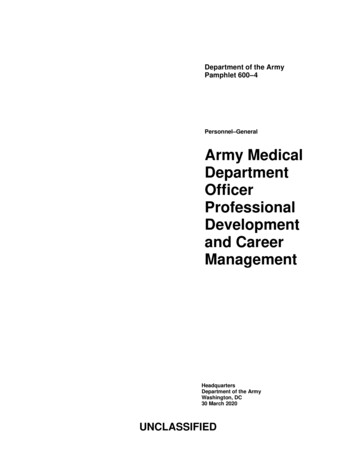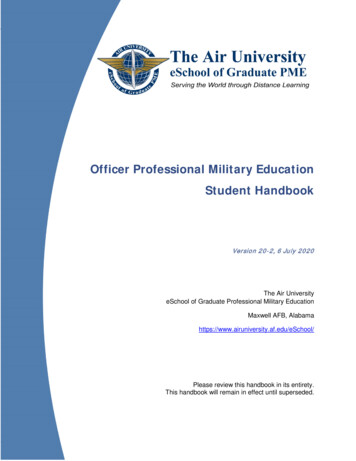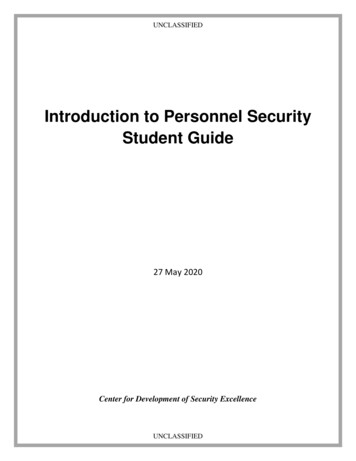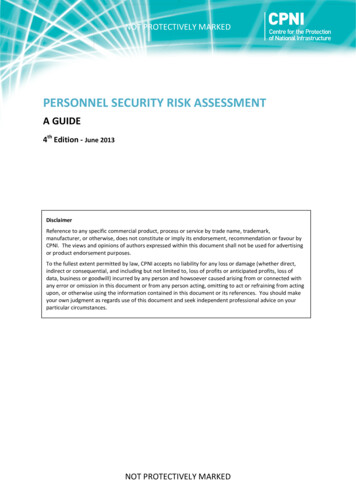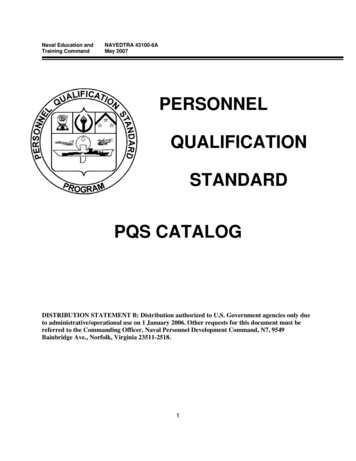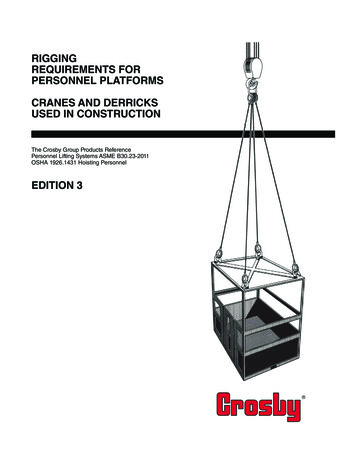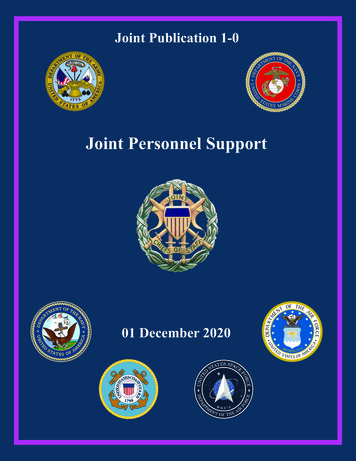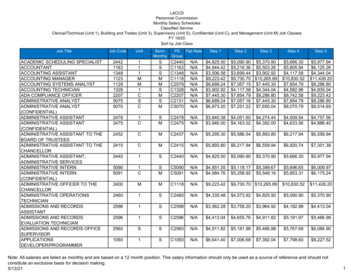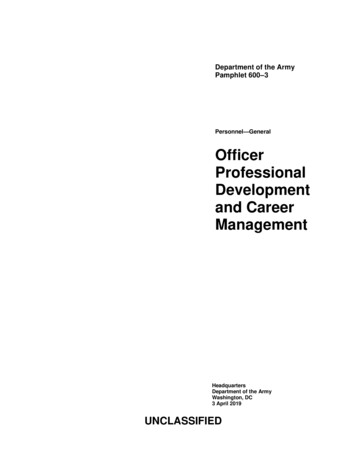
Transcription
Department of the ArmyPamphlet opmentand CareerManagementHeadquartersDepartment of the ArmyWashington, DC3 April 2019UNCLASSIFIED
SUMMARY of CHANGEDA PAM 600–3Officer Professional Development and Career ManagementThis expedited revision, dated 3 April 2019—oReplaces Expanded Graduate School Program with Performance Based Graduate School Incentive Program (para 3–5b(4)).oChanges the requirements for warrant officer development (paras 3–11b, 3–11c, and 3–11d).oAdds the regulations which manage Army National Guard officers and warrant officers (para 7–1b).oAdds the regulation which regulates the Ready Reserve (para 7–2b).oChanges skills, knowledge, and attitudes to align with FM 6–22 (throughout).
HeadquartersDepartment of the ArmyWashington, DC3 April 2019*Department of the ArmyPamphlet 600–3Personnel—GeneralOfficer Professional Development and Career Managementcan expect throughout a career. It emphasizes the need of the future force leader tobroaden and acquire a greater depth vicebreadth of experience in challenging leadership positions. In addition, this pamphletprovides a summary of the special branches(The Judge Advocate General’s Corps,Chaplain Corps, and U.S. Army MedicalDepartment).History. This publication is an expeditedrevision. The portions affected by this expedited revision are listed in the summaryof change.Summary. This pamphlet outlines officer development and career managementprograms for each of the Army’s careerbranches and functional areas. It does notprescribe the path of assignment or educational assignments that will guarantee success but rather describes the full spectrumof developmental opportunities an officerof colonel or the civilian equivalent. Activities may request a waiver to this pamphletby providing justification that includes afull analysis of the expected benefits andmust include formal review by the activity’s senior legal officer. All waiver requests will be endorsed by the commanderor senior leader of the requesting activityand forwarded through their higher headquarters to the policy proponent. Refer toApplicability. This pamphlet applies toAR 25–30 for specific guidance.the Regular Army, the Army NationalGuard/Army National Guard of the United Suggested improvements. Users areStates, and the U.S. Army Reserve, unless invited to send comments and suggestedotherwise stated. During mobilization, pro- improvements on DA Form 2028 (Recomcedures in this publication can be modified mended Changes to Publications and BlankForms) directly to the Deputy Chief ofto support policy changes as necessary.Staff, G–1 (DAPE–MPO), 300 Army PenProponent and exception authority.tagon, Washington DC 20310–0300.The proponent of this pamphlet is the Deputy Chief of Staff, G–1. The proponent has Distribution. This pamphlet is availablethe authority to approve exceptions or in electronic media only and is intended forwaivers to this pamphlet that are consistent Regular Army, the Army Nationalwith controlling law and regulations. The Guard/Army National Guard of the Unitedproponent may delegate this approval au- States, and the U.S. Army Reserve.thority, in writing, to a division chief withinthe proponent agency or its direct reportingunit or field operating agency, in the gradeContents (Listed by paragraph and page number)Chapter 1Introduction, page 1Purpose 1–1, page 1References and forms 1–2, page 1Explanation of abbreviations and terms 1–3, page 1Current perspective 1–4, page 1Warrior ethos and Army Values 1–5, page 1The Army profession 1–6, page 2Mentoring, counseling, and coaching 1–7, page 2Officer Personnel Management System overview 1–8, page 2Warrant officer personnel management overview 1–9, page 3Evaluation Entry System overview 1–10, page 4Chapter 2Officer Leader Development, page 5Leader development overview 2–1, page 5Leader development strategy 2–2, page 5*This pamphlet supersedes DA Pam 600-3, dated 26 June 2017.DA PAM 600–3 3 April 2019UNCLASSIFIEDi
Contents—ContinuedDomains of leader development 2–3, page 5Leader principles 2–4, page 6Leader development and the Officer Education System 2 –5, page 7Chapter 3Officer Personnel Management System and Career Management, page 8Purpose 3–1, page 8Factors affecting the Officer Personnel Management System 3–2, page 9Officer Personnel Management System 3–3, page 9Officer development 3–4, page 11Company grade development 3–5, page 13Major development 3–6, page 14Lieutenant colonel development 3–7, page 15Colonel development 3–8, page 16Warrant officer definitions 3–9, page 16Warrant officer career patterns 3–10, page 17Warrant officer development 3–11, page 17Introduction to officer skills 3–12, page 18Joint officer professional development 3–13, page 18Assignment process and considerations 3–14, page 20Individual career management 3–15, page 21Chapter 4Officer Education, page 22Scope 4–1, page 22The Officer Education System 4–2, page 22Current paths to officer education 4–3, page 22Guides for branch, military occupational specialty, or functional area development courses 4–4, page 22Nonresident schools and instruction 4–5, page 23Educational counseling 4–6, page 24Military schools 4–7, page 24Department of Defense and Department of State schools 4–8, page 24Foreign schools 4–9, page 24Language training 4–10, page 24Aviation training 4–11, page 24Command team training and education 4–12, page 24Other military schooling 4–13, page 25Application for military schools 4–14, page 25Service obligation 4–15, page 25Civilian education 4–16, page 25Education programs 4–17, page 25Tuition assistance 4–18, page 26Eligibility criteria and application procedures 4–19, page 26Chapter 5Officer Promotions, page 27General 5–1, page 27Promotion process objectives 5–2, page 27Statutory requisites 5–3, page 27Active duty list 5–4, page 27Promotion process 5–5, page 28Army grade structure 5–6, page 28Promotion flow 5–7, page 28Below-the-zone promotions 5–8, page 29Competitive categories 5–9, page 29Impact of the Officer Personnel Management System evolution 5–10, page 29iiDA PAM 600–3 3 April 2019
Contents—ContinuedChapter 6Officer Evaluation System, page 30Overview 6–1, page 30Officer evaluation reporting 6–2, page 30Relationship with the Officer Personnel Management System, leader development, and character development process 6–3, page 31Chapter 7Reserve Component Officer Development and Career Management, page 31Purpose 7–1, page 31Reserve Component overview 7–2, page 31Officer Personnel Management System 7–3, page 32Commissioned officer development 7–4, page 33Warrant officer development 7–5, page 34Management considerations 7–6, page 35Individual mobilization augmentee (U.S. Army Reserve – SELECT Reserve) 7–7, page 35Officer education 7–8, page 36Promotion 7–9, page 36AppendixesA. References, page 37GlossaryDA PAM 600–3 3 April 2019iii
Chapter 1Introduction1 –1. PurposeThis pamphlet serves primarily as a professional development guide for all officers. It does not prescribe the path of assignments or educational requirements that will guarantee success, but rather describes the full spectrum of developmentalopportunities an officer can expect for a successful career. This document also serves as a mentoring tool for leaders at alllevels and is an important personnel management guide for assignment officers, proponent, and Headquarters, Departmentof the Army (HQDA) election board members. Its focus is the development and career management of all officers of theU.S. Army.1 –2. References and formsSee appendix A.1 –3. Explanation of abbreviations and termsSee glossary.1 –4. Current perspectivea. Officer development for the Army should effectively balance breadth and depth of experience. Army operations areinherently joint. Officers must understand the terms of DODI 1300.19 and the Joint Qualification System. Officers shouldfocus on developmental positions that enhance career progression and lead to joint qualified officer status. All assignmentsare important to sustain a trained and ready Army. An officer’s focus should be on bringing the warrior ethos to every joband every facet of their development. Officers use challenging assignments at all levels to help them hone, through experience, what they have learned through their formal education about leading and training Soldiers. Operational factors—the constraints of time, Army requirements, positions available, and readiness—all influence the amount of time an officerwill need to acquire appropriate leadership skills. Success will depend not on the number or type of positions held, butrather on the quality of duty performance in every assignment. It is tied to individual contribution, and related to theindividual officer’s definition of success in the Army profession. Not all officers will be afforded opportunities to performall types of duty. The types and extent of duties and assignments are articulated in the following chapters. For this publication, the term "officers" encompasses warrant officers (warrant officers are appointed by commission at the grade ofchief warrant officer two (CW2)), company grade officers, and field grade officers. All officers are direct representativesof the President of the United States. Chapters relating to officer education, general promotion policies, and officer evaluation apply to all special branches as well. The governing regulations for this pamphlet are AR 600–3 and AR 350–1.b. Officers are encouraged to read both DA Pam 600–3 and Smartbook DA Pam 600–3, regardless of branch, functionalarea (FA), military occupational specialty (MOS), or career field held, because unique and valuable lessons in Army cultureand officer professional development are found in every section. The Smartbook DA Pam 600–3 is available a-pam-600–3.c. This pamphlet documents officer personnel management and incorporates the evolving philosophies of the Armyleadership. The Officer Personnel Management System (OPMS) enhances the warfighting capability of the Army, providesall officers with the information they need to ensure a reasonable opportunity for career success, and describes a frameworkthat fulfills Army requirements with an officer corps balanced with the right grades and skills. Successive personnel management studies have shown the need for a development and career management system that provides for the career development of the warrant officer segment of the Army’s officer corps. Better integration of warrant officers into the officercorps enhances the effectiveness and professionalism of warrant officers through improvements in training, development,assignment, promotion, and retention practices.1 –5. Warrior ethos and Army ValuesEverything begins with the warrior ethos. The warrior ethos compels Soldiers to fight through all conditions to victory nomatter how much effort is required. It is the Soldiers’ selfless commitment to the nation, mission, unit, and fellow Soldiers.It is the professional attitude that inspires every American Soldier. Warrior ethos is grounded in refusal to accept failure.It is developed and sustained through discipline, commitment to Army Values, and pride in the Army’s heritage. Warriorethos is the foundation for our total commitment to victory in peace and war. It is the conviction that military service ismuch more than just another job. It defines who officers are and what officers do. It is linked to this country’s longstandingArmy Values and the determination to do what is right and do it with pride. Soldiers enter the Army with their own values,DA PAM 600–3 3 April 20191
developed in childhood and nurtured through experience. We are all shaped by what we have seen, what we have learned,and whom we have met. However, once Soldiers put on the uniform and take the oath, they have opted to accept a warriorethos and have promised to live by Army Values. Army Values form the very identity of the Army. They are nonnegotiableand apply to everyone at all times, in all situations. The trust that Soldiers have for one another and the trust the Americanpeople put in us demands that we live up to these values. These values are interdependent; that is, they support one another.You cannot follow one value and ignore another. The seven values that guide all leaders and the rest of the Army areloyalty, duty, respect, selfless service, honor, integrity, and personal courage. Leaders must believe in them, model themin personal actions, and teach others to accept them. Officers require a demonstrated mastery of branch, FA, or MOSspecific skills, and grounding in these seven values to successfully lead Soldiers in to the future. Officer leaders who adopta warrior ethos and a joint, expeditionary mindset will be confident that they are organized, trained, and equipped to operateanywhere in the world, at any time, in any environment, against any adversary to accomplish the assigned mission.1 –6. The Army professiona. The Army profession assessed. In 2010, senior Army leadership directed the Commander, U.S. Army Training andDoctrine Command (TRADOC) to conduct a comprehensive review of the Army profession. This Armywide assessmentbegan in January 2011. The purpose was to assess how the Army has changed after more than 10 years of continuousdeployments and how it must adapt to remain successful in an era of persistent conflict.b. The Army profession defined. The Army is an American profession of arms, a vocation composed of experts certifiedin the ethical application of land combat power, serving under civilian authority, entrusted to defend the Constitution andthe rights and interests of the American people.c. The Army professional defined. An American professional Soldier is an expert, a volunteer certified in the professionof arms, bonded with comrades in a shared identity and culture of sacrifice and service to the nation and the Constitution,who adheres to the highest ethical standards and is a steward of the future of the Army profession.1 –7. Mentoring, counseling, and coachinga. Today’s leaders have the critical responsibility to develop future leaders who are prepared to meet tomorrow’s challenges. An essential component of this development is mentoring. The term mentorship refers to the voluntary, developmental relationship between a person of greater experience and a person of lesser experience that is characterized by mutualtrust and respect (see ADP 6–22 for additional information on mentorship).b. Mentorship impacts both personal development (maturity, interpersonal, and communication skills) as well as professional development (technical and tactical knowledge and career-path knowledge).c. The goal of mentorship is to assist the lesser-experienced person in reaching their personal and professional potential.It is critical to understand that mentorship is not any one behavior or set of behaviors, but rather includes all of the leaderdevelopment behaviors (for example, counseling, teaching, coaching, and role modeling) that are displayed by a trustedadvisor.d. The strength of the mentorship relationship is based on mutual trust and respect. Assessment, feedback, and guidanceaccelerate the developmental process and enhance performance. When this occurs within a mentoring relationship, evenhigher performance results.e. Mentoring requires taking advantage of any opportunity to teach, counsel, or coach to build skills and confidence inthe mentored. Mentoring is not limited to formal, structured sessions, but can include every event from quarterly trainingbriefs, to after action reviews, to unstructured, casual, recreational activities. To aid in the mentorship (and career management) process, the Army has developed and implemented the Army Career Tracker (available at https://actnow.army.mil),an Army leadership development tool that uses the professional development model (PDM) and provides a common pictureof training and experience. Used properly, this tool facilitates structured mentorship and can be utilized and revised bysuccessive mentors as an officer progresses in experience. Additionally, the Army Mentorship Program (available athttps://myarmybenefits.us.army.mil) is an official effort to provide additional resources for leaders and junior officers.f. One of the most important legacies that today’s senior leaders can leave with the Army is to mentor junior leaders tofight and win future conflicts. Mentoring develops great leaders to lead great Soldiers.1 –8. Officer Personnel Management System overviewa. Historical perspective. The OPMS was instituted in 1972, as a result of the U.S. Army War College Study on Military Professionalism and a follow-on analysis directed by the Deputy Chief of Staff (DCS), G–1. Numerous changes inpersonnel management policy were incorporated into OPMS between its implementation in 1975 and 1981. After passageof the Defense Officer Personnel Management Act (DOPMA) by Congress in 1981, the Chief of Staff, Army (CSA),ordered a major review to examine the impact of the legislation on OPMS policies. As a result, OPMS II was developed2DA PAM 600–3 3 April 2019
in 1984 to accommodate the changes brought about by DOPMA. These proposals were implemented beginning in 1985.Two years later, the CSA directed a review of officer leader development to account for the changes in law, policy, andprocedures that had occurred since the creation of OPMS II. As a result of the study, the Leader Development Action Planwas approved for implementation in 1989. Over 50 recommendations representing the latest revisions to the officer personnel system were incorporated into OPMS. The Army has undergone significant changes with widespread effect on theofficer personnel system, brought about by the drawdown at the end of the Cold War and by major legislative initiatives.Public Law (PL) 99–433, commonly referred to as The Goldwater-Nichols Act, required the Services to improve interoperability and provided the statutory requirements for joint duty assignments, joint tour credit, and joint military education.This law also specified the acquisition experiences and education necessary for an officer to be the project manager of amajor weapons system. PL 102–484 contained Title XI Army Guard Combat Reform Initiative legislation, which placedadditional officer requirements on the Regular Army (RA) in their support of the Army National Guard (ARNG) and U.S.Army Reserve (USAR). In 1996, the Reserve Officer Personnel Management Act (ROPMA) was enacted by PL 103 –337and brought the Reserve Component (RC) officer promotion systems in synchronization with the Active Component (AC).With an 8-year span since the last formal OPMS review, the DCS, G–1 assembled a team of senior field grade officers toexamine a series of OPMS-specific issues and determine whether a general review of the entire officer system was warranted. The OPMS XXI Precursor Study Group, under the direction of Commanding General (CG), U.S. Army HumanResources Command (HRC), ultimately reviewed more than 60 individual issues. Based on the collective body of theseissues, the DCS, G–1 recommended to the CSA that a comprehensive review of the OPMS was necessary. As a result, theOPMS XXI Task Force convened in July 1996 to review and recommend changes to the OPMS. Consistent with the taskof developing capabilities to meet the challenges of the next century, the CSA instructed the task force to link their workwith other ongoing Army planning efforts. The focus was to take the Army in a direction to meet its vision of the futureinstead of simply solving individual problems. The task force concluded that OPMS should incorporate a holistic, strategichuman resource management approach to officer development and personnel management. In ad
This expedited revision, dated 3 April 2019— o Replaces Expanded Graduate School Program with Performance
